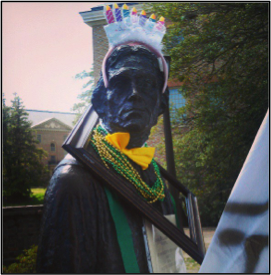The Internet is a Visual Place: 5 Tips for Higher Education

Here at EVG, it’s no secret that “the Internet is a visual place” has been my mantra for the past year, and I’m not alone. Content marketers have been vocal about how visual content can tell stories and drive engagement.
Social media is the poster child for the efficacy of images and videos; how many personal Facebook movies have shown up in your Facebook news feed in the past 48 hours? Beyond anecdotal experience, a host of studies demonstrate the power of imagery to significantly increase the rate of engagement. Hubspot’s 2012 study found that Facebook posts with pictures had 104% more comments and 53% more likes than those without pictures.
Recently Higher Education Marketing published a blog post about leveraging the power of images. Aside from the careless repetition of the unsubstantiated ‘fact’ about how quickly our brains process visual data, the article makes a compelling case for why higher education should be making a concerted effort to utilize images as priceless content to engage with prospective students, alumni, parents and fans.
 We all know about a picture and its worth. Statisticbrain.com notes that in 2013 the average attention span was 8 seconds (a gold fish’s was 9 seconds), which is a 4 second decrease from 2000. The site also reported that faced with a page of with 111 words or less, we’ll read nearly half of the words. If the page has 593 words, our reading rate drops to 28%. Now think about looking at a picture. Do you look at the entire image, or do you glance at a quarter of it? That’s the power of a photo.
We all know about a picture and its worth. Statisticbrain.com notes that in 2013 the average attention span was 8 seconds (a gold fish’s was 9 seconds), which is a 4 second decrease from 2000. The site also reported that faced with a page of with 111 words or less, we’ll read nearly half of the words. If the page has 593 words, our reading rate drops to 28%. Now think about looking at a picture. Do you look at the entire image, or do you glance at a quarter of it? That’s the power of a photo.
Whether the goal is to increase engagement with one’s followers on Facebook or Pinterest, encourage more potential students to visit campus, or to convince donors to part with their hard-earned dollars to support a capital campaign, just uploading any image isn’t going to work. Here are five tips to develop a winning strategy.
1. Align goal, audience and platform
Not all channels have the same audience, so think about whom you’re trying to reach, what they want and need and what you want to achieve. Pinterest’s new Place Pins can literally transform a campus visit feature into something fresh and new if you think outside the box. Scavenger hunt, anyone?
2. Think in terms of what you would share
Google rewards websites, and that includes social media sites, that offer fresh content that users deem valuable enough to share. What do you find yourself sharing? Are you doing that across all your platforms?
3. Ask students to tell their stories through images and videos
Transparency is the current buzz word, and here’s the ideal opportunity to utilize the power of your on-campus experts to tell their authentic stories. Think of it another way: Who better to “sell” the university experience to a prospective student than one of their peers?
4. Share expertise with curation
It need not all be your original content; scour the Internet and share the best of it. Ask your faculty to share what they find valuable.
 5. Employ a rich, diverse approach
5. Employ a rich, diverse approach
Every member of the faculty and staff, not to mention the entire student body has a unique perspective about their campus experience. Ask them to share it, think beyond the obvious photo ops, and consider the day-to-day moments you take for granted. Often those little things, like cookies in the dining hall or backstage moments in the theatre, are what live on in alum’s hearts and memories.
If you’re challenged by how to best tell your story, consider asking the experts at EVG for advice.
Learn more about EVG’s content marketing services for higher education.
Kathleen Gossman – Project Manager

 5. Employ a rich, diverse approach
5. Employ a rich, diverse approach

